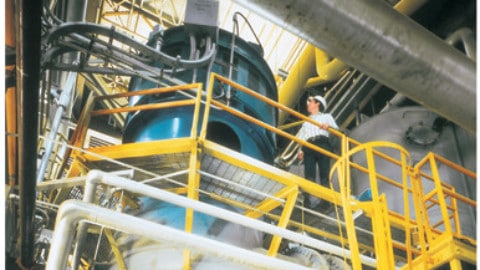By David A. Coyle and Vinod Patel, Kellogg Brown and Root, Inc, Houston, Texas
Last year we looked at pump services in the LNG production process. Once the LNG is shipped, there is a second series of processes to import and regasify the LNG. This process also involves a number of pumps.
The LNG receiving terminal (sometimes called a “regas” facility) receives liquefied natural gas from LNG ships, stores the LNG in storage tanks, vaporizes the LNG, and then delivers the natural gas into a distribution pipeline. The receiving terminal is designed to deliver a specified gas rate into a distribution pipeline and to maintain a reserve capacity of LNG. The amount of reserve capacity depends on expected shipping delays, seasonal variations of supply and consumption, and strategic reserve requirements (strategic reserves are needed when the terminal may be called upon to replace another large source of gas from either a pipeline or another receiving terminal on short notice). A simplified process flow diagram is shown in Figure 1.
The LNG terminal consists of the following:
LNG unloading system, including jetty and berth
LNG is transferred to the onshore LNG tanks by the ship pumps. The unloading facility is often designed to accommodate a wide range of tanker sizes from 87,000 m3 to 165,000 m3, though larger sized “Q-Max” ships up to 266,000 m3 are becoming common on Qatar trade routes. It takes approximately 12-14 hours to unload one 165,000 m3 ship, though the larger ships can take longer. From the ship, the LNG flows through the unloading arms and the unloading lines into the storage tanks. The loading lines can be two parallel pipes, each 24 or 26 inches diameter or a single 30 inch or larger pipe.
LNG storage tanks
Two or more above ground tanks are generally installed for receiving and storing LNG, though terminals have been built with a single tank. To reduce cost, designers try to minimize the number of tanks and maximize the amount of storage per tank. If the facility has only one tank then sendout and LNG unloading will be from the same tank, but this does not cause any operating difficulties. The types of tanks are similar to the ones used for liquefaction facilities. The decision to use single, double, or full containment is based on cost, land availability, and sometimes protection from external events such as vapour cloud blast pressure, and missiles or small aircraft.
Vapour handling system
During normal operation, boil-off vapour is produced in the tanks and liquid-filled lines by heat transfer from the surroundings. This vapour is collected in the boil-off header that ties into the boil-off compressor suction drum. A Boil-Off Gas (BOG) recondenser may also be provided which serves to recover the BOG as product and provides surge capacity for the LNG second stage pumps. During ship unloading, the quantity of vapour in the tank outlet increases significantly.
During upset, extreme turndown or emergency conditions, vapours may be generated within the terminal that exceeds the capacity of the pipeline compressor. If this occurs the vapours vent to the atmosphere through an elevated vent stack or a flare for safe disposal. In the case of a vent stack the vapours are preheated if necessary to avoid flammable mixtures near ground level.
LNG vapourisers
LNG terminal facilities have multiple parallel operating vapourisers with spares. Open Rack Vapourisers (ORV) are common worldwide (although they are not used much in the US terminals to date) and use seawater to heat and vaporize the LNG. The Submerged Combustion Vapouriser (SCV) uses send-out gas as fuel for the combustion that provides vaporizing heat. Because of the seawater system cost, the ORV’s tend to have a higher installed capital cost while the SCV’s have a higher operating cost because of the fuel charge. At many facilities the best economics are achieved by using ORV’s for normal send out and SCV’s as spares.
Other site factors also impact the decision of whether to use ORV’s or SCV’s. If the seawater temperature is below 42oF, ORV’s are usually not practical because of seawater freezing. At some sites, it is not practical to separate the seawater discharge from the seawater inlet, and SCV’s must be installed to avoid recirculation problems. The submerged combustion vapourisers also have environmental issues because of NOx emissions and the water combustion product that requires treating before discharge.
Open rack vapourisers
Seawater in an open falling film type arrangement vaporizes LNG passing through the tubes (see Figure 2). The water falls over aluminium panels and collects in a trough below before discharging back to the sea. The seawater first passes through a series of screens to remove debris before entering the intake basin. Raked bar screens provided in the inlet of the intake basin remove floating debris and provide protection for the vertical seawater and firewater pumps in the basin. The pumps are located in individual separate bays within the intake basin. At the inlet of each seawater pump bay, a travelling band screen may be provided for further removal of suspended solids to prevent blockage or damage to the open rack vapourisers. The larger single ORV units installed are for a gas send-out rate of approximately 200 to 250 MMSCFD.
Submerged combustion vapourisers
These vapourisers burn the natural gas taken from the send-out gas stream and pass the hot combustion gases into a water bath that contains the heating tubes for LNG (see Figure 1). The largest single SCV units installed are for a gas send-out rate of approximately 150 MMSCFD.
First stage send-out pumps
Several low-head LNG send-out pumps are installed in each LNG storage tank. These pumps are similar to the loading pumps at the LNG liquefaction facility, except the send-out rate is much lower than the loading rate therefore the pumps are smaller. A very large receiving terminal will have a sendout rate of 2 Billion Standard Cubic Feet per Day (BSCFD) while the ship unloading rate is closer to 5 BSCFD. The discharge pressure of the 1st Stage Sendout Pumps is around 8 barg.
Second stage sendout pumps
The send-out gas is usually injected into a high pressure gas distribution system of approximately 80 barg. For this pressure, multi-staged send-out pumps (booster pumps) are required. The pumps are high-head and take LNG from the first stage pump discharge and boost up the pressure to the vapourisers at the required pipeline pressure.
Receiving terminals to date are expected to operate close to 365 days per year and have spared equipment to achieve this availability. In at least one case a terminal operated over three years continuously and was shutdown only for a statutory inspection. In spite of the traditionally high terminal availability, spare equipment can be eliminated and cost savings achieved if the gas consumers can tolerate interruptions in the send-out supply.
- Figure 1.
- Figure 2.
- Figure 3.




















